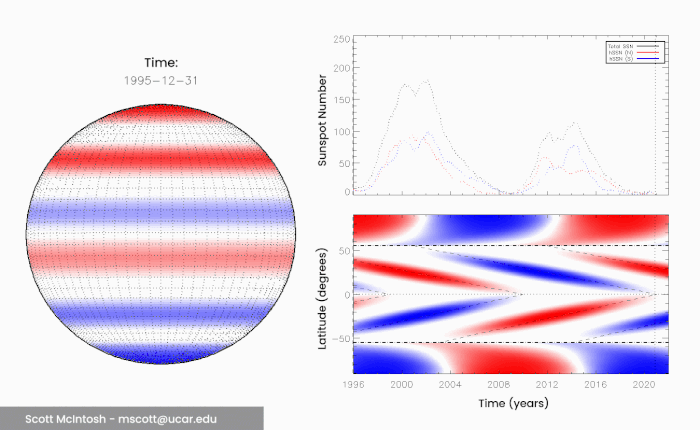The Sun may be in for a very busy time. According to new predictions, the next maximum in its activity cycles could be the one of the strongest we've seen.
This is in direct contradiction to the official solar weather forecast from NASA and the NOAA, but if it bears out, it could confirm a theory about solar activity cycles that scientists have been working on for years.
"Scientists have struggled to predict both the length and the strength of sunspot cycles because we lack a fundamental understanding of the mechanism that drives the cycle," said solar physicist Scott McIntosh of the US National Center for Atmospheric Research.
"If our forecast proves correct, we will have evidence that our framework for understanding the Sun's internal magnetic machine is on the right path."
The Sun's activity levels are actually quite variable, and its activity cycles are bound up with its magnetic field.
Every 11 years, the Sun's poles swap places; south becomes north and north becomes south. It's not clear what drives these cycles, but we do know that the poles switch when the magnetic field is at its weakest.
Because the Sun's magnetic field controls its activity - sunspots (temporary regions of strong magnetic fields), solar flares, and coronal mass ejections (produced by magnetic field lines snapping and reconnecting) - this stage of the cycle manifests as a period of very minimal activity. It's called the solar minimum.
Once the poles have switched, the magnetic field strengthens, and solar activity rises to a solar maximum before subsiding for the next polar switch.
Generally, we track solar minima by keeping a careful eye on solar activity and working out after the fact that one has occurred. By this metric, the most recent solar minimum took place in December 2019. We're now in the 25th solar cycle since record-keeping began, headed into a solar maximum.
According to NASA and the NOAA, this is expected to be a quiet maximum, with a sunspot peak of around 115 sunspots in July 2025. This is pretty similar to Solar Cycle 24, which had a sunspot peak of 114.
But McIntosh and his colleagues believe differently. In 2014, he and his colleagues published a paper describing their observations of the Sun on a 22-year cycle.
This has long been considered the full solar cycle, when the poles return to their starting positions, but McIntosh noticed something interesting. Over the course of about 20 years or so, flickers of extreme ultraviolet light called coronal bright points seem to move from the poles towards the equator, meeting in the middle.
The movement of these bright points across the mid-latitudes seems to coincide with sunspot activity.

These bright points, McIntosh believes, are linked with bands of magnetic fields that wrap around the Sun, propagating from the poles to the equator every 11 years or so.
Because they have opposite polarity, when they meet in the middle, they cancel each other out - what the researchers call a "terminator". These terminator events mark the end of a solar magnetic cycle, and the start of the next.
But they don't always take exactly the same amount of time. Sometimes these bands slow down as they reach mid-latitudes, which means that the length of time between terminator events varies. And the team noticed that there's a correlation between the length of time between terminators and the intensity of the following solar maximum.
"When we look back over the 270-year long observational record of terminator events, we see that the longer the time between terminators, the weaker the next cycle," said astronomer Bob Leamon of the University of Maryland Baltimore County.
"And, conversely, the shorter the time between terminators, the stronger the next solar cycle is."
The longest cycle on record based on time between terminators is Solar Cycle 4, which lasted over 15 years. It was followed by the famous Dalton minimum - a peak of just 82 sunspots in Solar Cycle 5, which lasted nearly 14 years, and 81 sunspots in Solar Cycle 6.
But shorter solar cycles - those that are less than 11 years - are followed by maxima with peaks well above 200 sunspots.
Solar Cycle 23, according to McIntosh's team's metric, was pretty long. It lasted nearly 13 years. And Solar Cycle 24 was much quieter than the cycles that preceded it. But it was also really short, coming in under the 10-year mark. If the team's analyses are in point, we should be in for a lot of sunspots by the mid-2020s.There's only one way to find out - we have to wait and see. But McIntosh and his team are confident in their interpretation of the Sun's activity. And, if they're right, that will give us a whole new toolset for understanding how the Sun works.
"Once you identify the terminators in the historical records, the pattern becomes obvious," McIntosh said.
"A weak Sunspot Cycle 25, as the community is predicting, would be a complete departure from everything that the data has shown us up to this point."
The research has been published in Solar Physics.



No comments:
Post a Comment